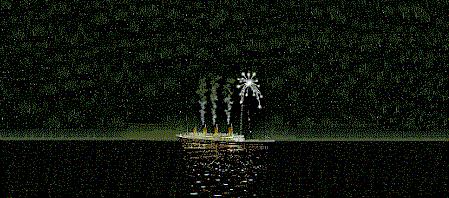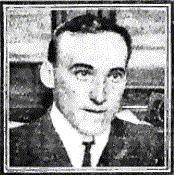

The time has come for us to pose our series of questions about the Californian to Leslie Harrison and to critically examine each of his replies. Our questions to Harrison will appear in bold type, and Harrison's replies will be bulleted immediately below each question. The present author's analysis of Harrison's replies will follow each question-and-answer block.
The author hopes that the reader will find the following exchange enlightening.
AUTHOR'S ANALYSIS: Leslie Harrison asks us to believe that Captain Lord saw a star rising above the eastern horizon and that Lord mistook this star for a ship's masthead light; Harrison claims that this misimpression was responsible for Lord's (allegedly) mistaken belief that the "mystery ship" had approached the Californian from the east.
This claim falls apart under close examination, however. It should be remembered that, although Third Officer Groves initially believed that the light he and Lord were watching was probably a star rising above the horizon, continued observation made it clear to Groves that the "star" was in fact a ship's masthead light. (The reader will note that Groves' supposition that the masthead light might be a RISING star confirms the fact that the mystery ship was approaching the Californian from the east - not from the southwest like Leslie Harrison claims.) Besides, Captain Lord himself never expressed the slightest doubt that the light he was observing was a ship's masthead light; indeed, Lord's sighting of this masthead light caused him to visit the Marconi cabin to find out which ships were within wireless range of the Californian.
As for Harrison's reference to Groves' testimony at the British Inquiry, Groves states: "About 11:10, ship's time, I made out a steamer coming up a little bit abaft our starboard beam.... When I spoke to him [Captain Lord] about the steamer coming up astern he was in the chartroom."
Since Californian was pointed toward the northeast at the time of Groves' sighting, Californian's starboard beam was facing southeast. A ship "a little bit abaft our starboard beam" would therefore have been roughly south-southeast of the Californian when Groves first saw her approaching. Even though Groves' later reference to the ship "coming up astern" was technically correct (since "abaft the beam" IS astern), Leslie Harrison carries his own interpretation of Groves' remark to its extreme limit and asserts that Groves saw the mystery ship DIRECTLY astern of the Californian [i.e. to the southWEST and moving from west to east.] Indeed, Harrison's entire book is based on this fallacy despite Captain Lord's specific testimony (BR 6717, 6719, 6728) that "It was approaching me from the eastward"; "It was on the starboard side"; and "I saw a green (side)light." (Even the Californian's Second Officer Stone testified that, when he came on duty at midnight, the Californian was pointed toward the ENE and the mystery ship was "on our starboard beam" - i.e. SSE of the Californian. BR8064-4.)

Leslie Harrison proudly proclaims that he never tried to change Captain Lord's mind regarding Lord's sighting of the mystery ship's green starboard sidelight (which would have faced the Californian as the mystery ship steamed westward.) Since Captain Lord's 1912 testimony was very specific regarding this green light, though, it would have done Harrison little good to try and get Lord to change his story in the 1960s. How, then, does Leslie Harrison deal with Lord's awkward sighting of the green sidelight? Easy. Harrison tells us that he simply "knew this could not be so" - which enables Harrison to discount Lord's observation altogether and continue on as if nothing had happened. (The present author finds it fascinating that Leslie Harrison is sometimes forced to pick and choose from Captain Lord's own testimony in order to come up with "evidence" that supports Harrison's personal beliefs.)

AUTHOR'S ANALYSIS: Mr. Harrison's statement is accurate in a literal sense - that is, he has never come right out and called Third Officer Groves a liar. There's a very simple reason for this - Harrison has never deemed it advisable to even TELL his readers about Groves' sighting of a big, brightly-lit passenger steamer near the Californian that night. (Indeed, Harrison has never drawn his readers' attention to any of the most damning evidence that Groves revealed at the British Inquiry.) By avoiding any open discussion of Groves' testimony Mr. Harrison has never found it necessary to publicly question Groves' honesty; in other words, as far as Leslie Harrison is concerned Third Officer Groves' sighting of the big passenger steamer "never occurred" - and therefore need not be refuted or explained. Needless to say, serious historians do not subscribe to the "out of sight, out of mind" method of historical research.
But that doesn't mean Leslie Harrison has completely ignored the thorny problem of Third Officer Groves. Although Harrison has never personally attempted to discredit Groves, his book does quote the opinion of another person (Robertson Dunlop) for the apparent purpose of influencing the reader and coloring his perception of Groves' reliability. Robertson Dunlop had been retained by the Leyland Line (owners of the Californian) to appear at the British Inquiry for the purpose of convincing the Inquiry that the Californian's watch officers did not see the Titanic that night. Dunlop cavalierly dismissed the reliability of Third Officer Groves' sighting of the big passenger steamer in the following manner:
"Groves attached no importance at the time to the vessel he had seen, and he attached no importance at all to any of the incidents which he described when here in the witness box; and I submit that his evidence was largely the result of imagination stimulated by vanity. So much with regard to the class of vessels seen."
As we pointed out a moment ago, Leslie Harrison has never dared to personally question the veracity of Groves' testimony. However, by quoting someone else's (Dunlop's) casual dismissal of Groves' integrity Harrison is still able to exert a subtle influence over his readers and predispose them to the opinion that Groves reveled in his participation at the Inquiry and was willing to falsify his evidence just to make his moment in the limelight more dramatic.
It is interesting to note that Leslie Harrison apparently made the above suggestion to Charles Groves himself during his correspondence with the Californian's former third officer. As we have already seen, on October 26, 1959 Groves wrote a reply to Harrison in which he denied having been influenced by Lord Mersey - or anyone else - at the British Titanic Inquiry; indeed, Groves told Harrison very emphatically that he was "astonished" by the above suggestion.
To summarize, then, the only way Leslie Harrison has been able to deal with Groves' most damning testimony against Captain Lord has been (1) to avoid all mention of such testimony in his book, and (2) to cast (indirect) aspersions upon Charles Groves' veracity so as to bias the reader against the Californian's third officer.
Needless to say, neither technique is looked upon with favor by legitimate historians.
At any rate, the reader might like to examine Third Officer Groves' testimony regarding the appearance of the ship he saw approaching the Californian that night:

AUTHOR'S ANALYSIS: Perhaps - or perhaps not; we now know that Captain Lord deliberately misled Boston newspaper reporters in an attempt to convince them that nothing unusual had occurred on board the Californian on the morning of April 15th. However, there might be another very good reason why Captain Lord could not recall Groves telling him about his sighting of the big passenger steamer that night; as Lord admitted to the British Inquiry, "Well, I have heard so many stories about the Titanic since that I really do not know what I heard that night."
Needless to say, Leslie Harrison has never told his readers that Captain Lord did not trust his own memory as to whether or not his Third Officer reported sighting a big passenger steamer that night.
AUTHOR'S ANALYSIS: The above-mentioned Inquiry question was directed at the Mt. Temple's Captain Moore:
The above one-sentence summary of the Mt. Temple's movements (and Moore's one-word assent to that summary) is the entire basis for Leslie Harrison's allegation that the Mt. Temple did not sight the Californian until 8 a.m. on the morning of April 15th. In focussing on this one-sentence summary, though, Harrison has completely ignored Captain Moore's TWO WHOLE PAGES of detailed Senate testimony that refute the accuracy of the above summary. The key portions of Moore's Senate testimony follow:
We know from Captain Lord's own testimony that the only time Californian was bound from east to west that morning was from 6 a.m. until 6:20 a.m. We have therefore determined three crucial facts from Captain Moore's above testimony: (1) Mt. Temple observed the Californian steaming from east to west between 6 a.m. and 6:20 a.m. (2) Californian was seen to be only five or six miles north of the disaster site at this time - two hours prior to the time that Captain Lord claimed the Californian neared the disaster site. (3) Leslie Harrison's claim that Californian was steaming SOUTH at 8 a.m. when she was first sighted by the Mt. Temple is absolutely false and is based on wishful thinking instead of on Captain Moore's detailed account of the matter.

AUTHOR'S ANALYSIS: Leslie Harrison's allegation that Californian contacted the Virginian at 8:20 a.m. (Californian ship's time) is absolutely false.
At the Senate Inquiry Captain Lord testified that at 6 a.m. (Californian Time) he had received an official message from the Virginian informing him of the Titanic's CQD position. Lord claimed that his next communication with the Virginian occurred about an hour and a half later (i.e. at around 7:30 a.m. Californian Time.)
However, Captain Lord was wrong about the time of his second communication with the Virginian. According to the Virginian's log (quoted to reporters by Captain Gambell, the vessel's master) only twenty-five minutes went by before the Virginian sent her second message to the Californian. In other words, Captain Lord received Virginian's second message at about 6:25 a.m. Californian Time.
The importance of this "minor detail" lies in the content of Virginian's 6:25 a.m. message as well as in the content of Californian's immediate reply:
In other words, the Californian could already see Carpathia recovering the Titanic's lifeboats at 6:25 a.m. - almost two hours before Leslie Harrison claims she did so.
As for Question 9165 and its predecessor (referred to by Leslie Harrison), these queries were directed at Cyril Evans, the Californian's wireless operator:
It is difficult to understand why Leslie Harrison feels that the time of Californian's initial wireless contact with the Carpathia has any bearing on the content of her earlier exchange with the Virginian. Harrison seems to think it means that Cyril Evans was unaware that Titanic had sunk until almost 8:30 a.m. - which implies that Evans could not have told the Virginian about the sinking until that time.
This supposition is untrue. Captain Lord testified that at around 5 a.m. on the morning of April 15th he and his chief officer were discussing the rockets that had been sighted during the night, and Lord told the chief officer to go awaken the wireless operator. Twenty minutes later the chief officer returned to the bridge with the news (obtained by wireless) that "There is a ship sunk." The chief officer went back to the Marconi room and returned a short time later to tell Captain Lord, "The Titanic has hit a berg and sunk."
In other words, Californian's wireless operator Evans knew about the Titanic's loss long before Californian neared the Carpathia that morning. Indeed, he knew about it at 6:25 a.m. when he related that fact to the Virginian - along with the news that Carpathia was already within sight of the Californian.
